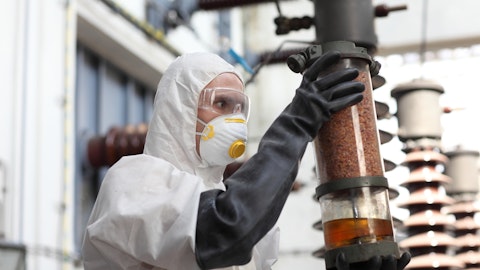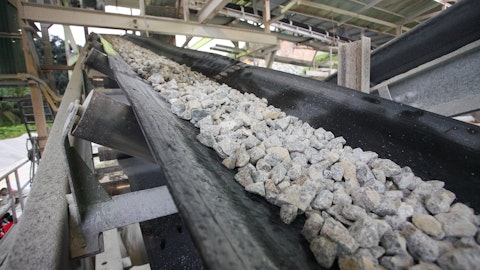Graco Inc. (NYSE:GGG) Q4 2023 Earnings Call Transcript January 30, 2024
Graco Inc. isn’t one of the 30 most popular stocks among hedge funds at the end of the third quarter (see the details here).
Operator: Good morning, and welcome to the Fourth Quarter Conference Call for Graco Inc. If you wish to access a replay for this call, you may do so by visiting the company’s website at www.graco.com. Graco has additional information available in the PowerPoint slide presentation, which is available as part of the webcast player. At the request of the company, we will open the conference up for questions-and-answers after the opening remarks from management. During this call, various remarks may be made by management about their expectations, plans and prospects for future. These remarks constitute forward-looking statements for the purpose of the safe harbor provision of the Private Securities Litigation Reform Act. Actual results may differ materially from those indicated as a result of the various risk factors, including those identified in Item 1A of the company’s 2022 Annual Report on the Form 10-K and Item 1A of the company’s most recent quarterly report on Form 10-Q.
These reports are available on the company’s website at www.graco.com and the SEC’s website at www.sec.gov. Forward-looking statements reflect management’s current views and speak only as of the time they are made. The company undertakes no obligation to update these statements in light of new information or future events. I will now turn the conference over to Chris Knutson, Executive Vice President, Corporate Controller.
Christopher Knutson: Good morning everyone, and thank you for joining our call. I’m here today with Mark Sheahan and David Lowe. I will provide a brief overview of our quarterly results before turning the call over to Mark for additional commentary. Yesterday, Graco reported fourth quarter sales of $567 million, an increase of 2% from the fourth quarter of last year. The effect of currency translation increased sales by one percentage point or approximately $6 million. Reported net earnings decreased 13% to $110 million for the quarter or $0.64 per diluted share. In December, the company transferred $147 million of its pension obligations to an insurance company through the purchase of an annuity contract. In connection with the transfer, we recognized a non-cash pre-tax pension settlement charge of approximately $42 million recorded in other non-operating expense.
Excluding the impact of this pension settlement loss, certain non-recurring tax provision adjustments and excess tax benefits from stock option exercises, adjusted non-GAAP net earnings were $137 million or $0.80 per diluted share, an increase of 10%. The gross margin rate increased 370 basis points in the quarter. Strong price realization and lower product costs were more than enough to offset lower factory volumes. Total operating expenses increased $10 million or 8% in the quarter, mainly due to volume and rate-related increases of $3 million as well as higher sales and earnings based expenses of $3 million. Gross margin rate improvement more than offset these increased operating expenses during the quarter, resulting in operating margin rate growth of 2.5 percentage points.
The adjusted effective tax rate was 19% for the quarter. Cash provided by operations totaled $651 million for the year, an increase of $274 million from last year. mostly driven by higher net earnings and a reduction in inventory purchases. Cash provided by operations as a percent of net earnings is 129% for the year. Significant year-to-date uses of cash include dividends of $158 million, share repurchases of $102 million, which were offset by share issuances of $60 million, debt repayment of $75 million and capital expenditures of $185 million, including $108 million of facility expansion projects. A few comments as we move forward to 2024. Based on current exchange rates, assuming the same volumes, mix of products and mix of business by currency as in 2023, movement in foreign currencies would have no impact on net sales or net earnings for the full year.
Unallocated corporate expenses are projected to increase to a range of $41 million to $44 million with the increase related to share-based compensation. The effective tax rate is expected to be 19.5% to 20.5%, excluding any impact from excess tax benefits related to stock option exercises and other onetime items. We expect capital expenditures to be approximately $120 million, with $60 million for facility expansion projects. Since 2018 and through 2024, we will have invested nearly $500 million to expand our global manufacturing capacity. By the end of this year, we will have completed expansion projects for nearly all of our operations which should set us up for several years of growth. I’ll now turn the call over to Mark for further segment and regional commentary.

Mark Sheahan: Thank you, Chris. Good morning, everyone. All my comments this morning will be on an organic constant currency basis. Sales in the fourth quarter were up low single digits, resulting in quarterly and annual records for both revenue and operating earnings. Our Industrial and Process segments saw record annual sales and I’m encouraged by the fourth quarter sales growth in our Contractor segment. All segments finished the year with record annual operating earnings. Pricing actions implemented in late 2022 and at the beginning of 2023 drove sales growth and gross margin expansion during the quarter and for the year. Our strong price realization across all businesses and regions, combined with improved product availability, stable product costs, and favorable product and channel mix and contractor resulted in meaningful improvement in our gross margin rate.
These improvements resulted in company-wide incremental margins of nearly 150% for the year. Adjusted net earnings expressed as a percentage of sales was 24% for the year, which is the highest in company history. Pricing actions taken in early 2024, closely resembled traditional levels in terms of size and cadence with all segments and regions initiating price increases at the beginning of the year. At the end of 2023, our consolidated backlog was $280 million, which was $75 million below last year’s ending backlog. Backlogs have returned to normal levels within most product categories, but continue to remain slightly elevated in our semiconductor and powder coatings businesses. Now turning to some commentary on our segments. Contractor segment sales improved in the fourth quarter, growing at low single digits.
Soft demand in the home center channel and challenging global construction markets remain headwinds. However, new product introductions and continued strength in the Protective Coatings and spray foam product categories were more than enough to offset these headwinds in the quarter. Operating earnings were 29% for the quarter and for the year as contractor benefited from pricing actions and favorable product mix by selling larger professional units and fewer home center units. Heading into 2024, we’re cautiously optimistic about business conditions based on improving global construction indicators. As affordability improves, new and existing home sales are predicted to increase throughout the year, along with expected growth in commercial and non-residential spending.
The Industrial segment achieved record sales and earnings for the year, despite 1% revenue decline in the fourth quarter compared to last year. Growth in liquid finishing and sealant and adhesive product lines were not enough to offset the impact of lower powder finishing system sales in EMEA and Asia Pacific in the quarter. Fourth quarter 2022 represented peak revenue for our powder finishing group as projects delayed during the pandemic were completed and placed into service. Our Process segment grew 4% in the quarter and 11% for the year. For the year, we saw growth in all regions and reported record earnings. Increases were posted for the quarter in many business units and across all reportable regions, led by double-digit growth in vehicle services and process pumps.
Price realization and increased volume drove incremental margins of 89% in the fourth quarter and 83% for the full year. We had broad-based revenue growth in all our businesses this year, resulting in record operating profit margins for the segment. Moving on to our outlook. As we enter 2024, we’re keeping a close eye on incoming order rates and global economic indicators. Despite difficult macroeconomic environment, we remain committed to our core strategies of launching new products, entering new markets, expanding our global channel and pursuing strategic acquisitions. As a result, we’re initiating revenue guidance for full year 2024 of low single-digit growth on an organic constant currency basis. That concludes the prepared remarks. Valerie, we’re ready for questions.
Operator: [Operator Instructions] Our first question comes from the line of Deane Dray of RBC Capital Markets.
Deane Dray: Thank you. Good morning everyone.
See also 15 Cheapest Countries to Get Second Citizenship and 15 Most Unfriendly Countries in Europe.
Q&A Session
Follow Graco Inc (NYSE:GGG)
Follow Graco Inc (NYSE:GGG)
Christopher Knutson: Hi Deane.
Deane Dray: Maybe we could start with pricing. And Mark, you gave the kind of the broad brush comments that it’s back into the single price increase and it’s representative of what would be normal price across the board. Maybe talk about the expectation for new product introductions. And then where does the — on the cost equation, it sounds like labor inflation is still around, is there anything else? Are we back to normal on the rest of the cost side?
Mark Sheahan: Yes, so the pricing actions, again, there — I’d say they’re more in line with what we’ve done historically, kind of inflationary plus or minus a little bit. All the business units are implementing increases as are all the regions so we feel pretty good about that getting back to a normal cadence there. Of course, if things change, we know we can make an adjustment if we need to, but it doesn’t look like that’s going to be the case this year. Our cost pressures for the full year in the plan were still unfavorable compared to what we were expecting them to be but we did start to see a little bit of light at the end of the tunnel here as we work through the year, in the fourth quarter things turned slightly favorable.
So if those trends continue, I am hopeful that we would see some impact — some favorable impact on the gross margin line as we kind of work through the year. Labor is tight. We did just raise our wages in line with what the market is but even though it’s tight, we have not really experienced any major difficulties in terms of attracting people to join Graco. It’s a great company. We’re growing. We have a great story to tell. And even though we have people retiring all the time, we’re able to fill those positions pretty readily. So feel pretty good as we enter into the year, and we’ll see what happens.
Deane Dray: Great. And then just as a second question, going to our favorite traffic light slide, can you just comment on the changes versus last quarter? So improved outlook in Industrials America, but Industrials Asia Pacific dipping and process Americas look also has worsened. I know you touched on the powder finishing impact, but kind of reconcile some of those changes with what’s actually going on in the business and order expectations?
David Lowe: Okay. This is David Lowe. As far as North America Industrial goes, what we have seen there is pretty good project activity throughout the second half of 2023, the team reports strength in a number of our core markets, I’ll just ramble off two or three. E-Mobility has continued to be strong here in the home market, aerospace, solar panel, agricultural equipment. And we’re hopeful that suggests that we’re going to have positive momentum going into ’24. So we thought that was worthy of refinement. I think on the industrial Asia Pacific side, we clearly have a mixed picture in Asia, and one of the — I’d say, the most impacted markets for us has been — it falls into industrial, but it’s the construction activity that drives powder coating applications, and that continues to be soft space for us.
And the picture, especially in China, remains murky at best. So I think that’s at least a reflection of how we see the business today. And finally, on process in the Americas overall, as Mark touched on, the business has been strong but we continue to see some softening in orders in the semiconductor space, sort of consistent with the messaging that’s going on around in the industry here. I should add, the business continues to be strong in markets outside of North America.
Deane Dray: That’s really helpful. Just a quick clarification, David, please. You mentioned the weakness in China. We had a company report this morning that referenced weakness in China, no less than 14 times in their prepared remarks, do you have — has there been any discernible downshift in China? It’s been weak pretty consistently, but let’s say, in the last couple of months, as it turned more negative for you? Just any color there would be helpful.
David Lowe: I would say the quick answer. I’ve got a cheat sheet here. I’d say it has not. I’m going to check this, while I’m —.
Mark Sheahan: I think that the overall China has been weak for us. And I would say that the couple of the areas that have been the weakest have been in our contractor business and our powder coating business. But overall, it’s kind of been an ongoing theme for us throughout the year.
David Lowe: I would say the throughout — Mark is exactly right. Throughout the whole year, it’s been soggy on the order rates I would say we saw modest for what it’s worth. We don’t really think of our businesses these ways is turning around in a couple of months or a quarter, but the rate of — I would say the rate of softness has decreased, I mean, partly because we’re working through the period of the toughest comps in 2022.
Deane Dray: Thank you.
Mark Sheahan: Thanks Deane.
Operator: Thank you. One moment please. Our next question comes from the line of Michael Halloran of Baird. Your line is open.
Michael Halloran: Hi, good morning everyone.
Mark Sheahan: Hi Mike.
Michael Halloran: So a couple of questions here. First, 2023 was a massive year for margins across the board here. We’re talking about more normalized price, how do we think about what the right run rate looks like as we work through this year. Process had a mini step down in the fourth quarter, but was 30% plus all year, Industrial’s at these really large levels. You compare that to ’22 and earlier it was just a sea change. So is this sea change at this higher level, the right run rate across the businesses or should we be thinking about something different?
Mark Sheahan: Yes, I feel good about it. I really think that the businesses are performing extremely well. I think the factories are doing well on lower volumes. It’s really to be a volume game for us here in ’24. If we get volume growth above what we’re guiding, it’s going to be pretty nice. We’ve got capacity to utilize and I really feel like the factories are in good shape to be able to deliver higher revenue. We have the low single-digit guide mostly because if you look out at the global trends, they are trending below normal levels, I would say. And we also have a little bit of inflation sticking around the world, too, and you never really know how that’s going to play out. And then you’ve got other factors that all kind of went in that low single-digit number, even though we’re getting some pricing and we’ve got really nice new products coming out.



